Growing rice is a very complicated matter and it requires a lot of work and effort, including also the fact that it is necessary to spend a great deal of time in muddy waters almost knee-high. As opposed to the other grains that may be grown on wavy terrain as well, in order to cultivate rice it is necessary to have perfectly flat terrain, since during its vegetation cycle, rice requires a lot of water. And in order for this water not to spill over, the flat terrain in which the rice is planted is bounded by mildly elevated earth, like a hedge.
Because of this specificity related to its cultivation, rice simply cannot be grown on a slope, even if it is mild, the hard-working people from this part of Vietnam have made numerous narrow paddies on the steep slopes of the mountains thus succeeding in utilizing the soil for the growing of their staple food. Look on the internet and you will see truly pretty photos.
But, this did not look so pretty at all at the beginning of January, when Sneza and I did some “trekking” around Sa Pa, going towards the village in which we were to stay at the house of Chai who was our guide. It rained incessantly and while walking along the road that cut through the slopes of the mountains that constitute this landscape we even passed by a large concrete platform which had obviously been built there to serve as a view-point so that passers-by could look at the surrounding landscape and enjoy it. We had none of that. Everything around the road was filled with mist and clouds. So, we just glanced towards the platform and continued treading on. In that rain, as well as in cold weather (it was less than 10 degrees Celsius), we had to cover almost 10 kilometres which is the distance between Sa Pa and the village of Ta Van.
After a while we came across another view-point and just as we passed it, I noticed by chance that the clouds had just started to thin out. I stopped and saw that something was really going on there, so I almost ran uphill back to the platform, crossed to the fence of that large balcony walking through water that had gathered there, but I did manage to catch a minute or two when the clouds dispersed “under” the balcony (it was still cloudy above me and it still kept raining). I cannot begin to tell how happy and satisfied I was, as if I had been given a special treat from the Universe. I started taking photos both with my regular camera and with my video camera in order to make sure that I had at least a photo or two of the famous Sa Pa paddies. The colour of the fields was no longer important. After that short time span, the clouds gathered again and it was as if a window was shut. You saw what you saw and that was it.
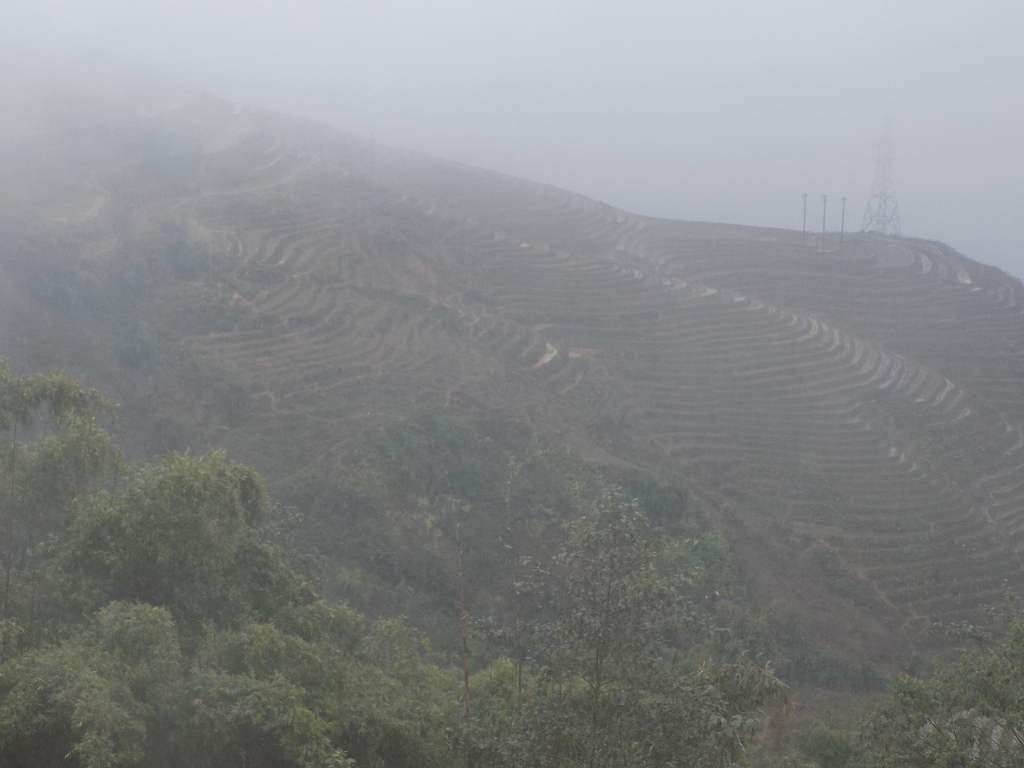 The clouds are thinning out and the paddies start to appear
The clouds are thinning out and the paddies start to appear
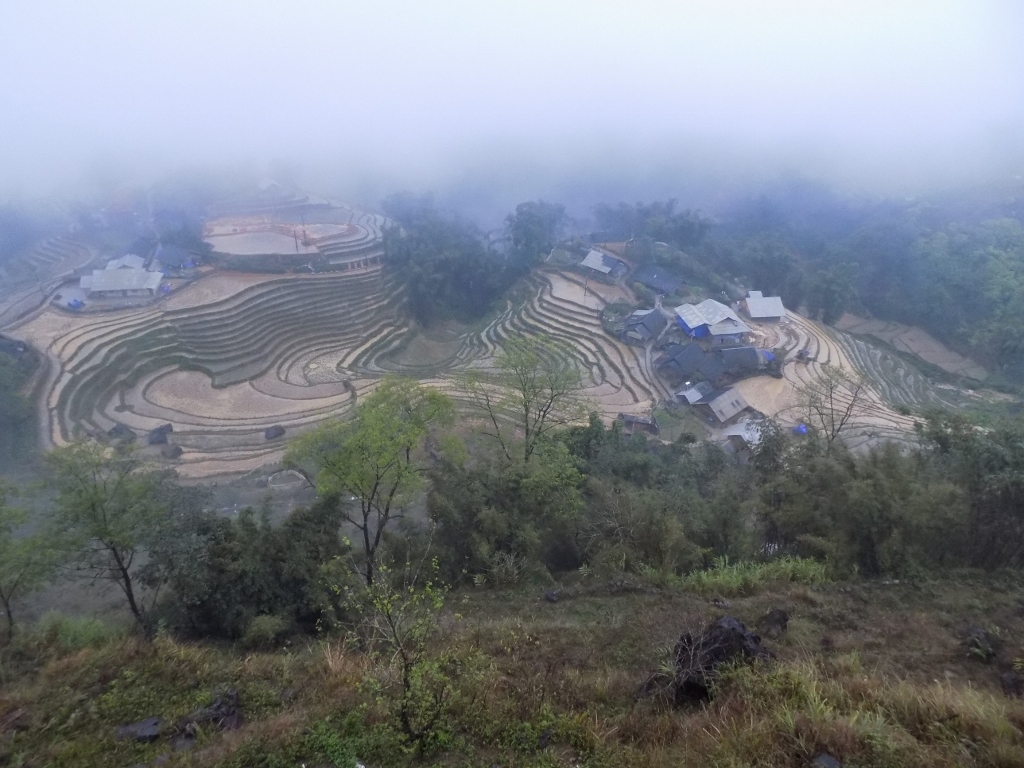 View at a property from the view-point
View at a property from the view-point
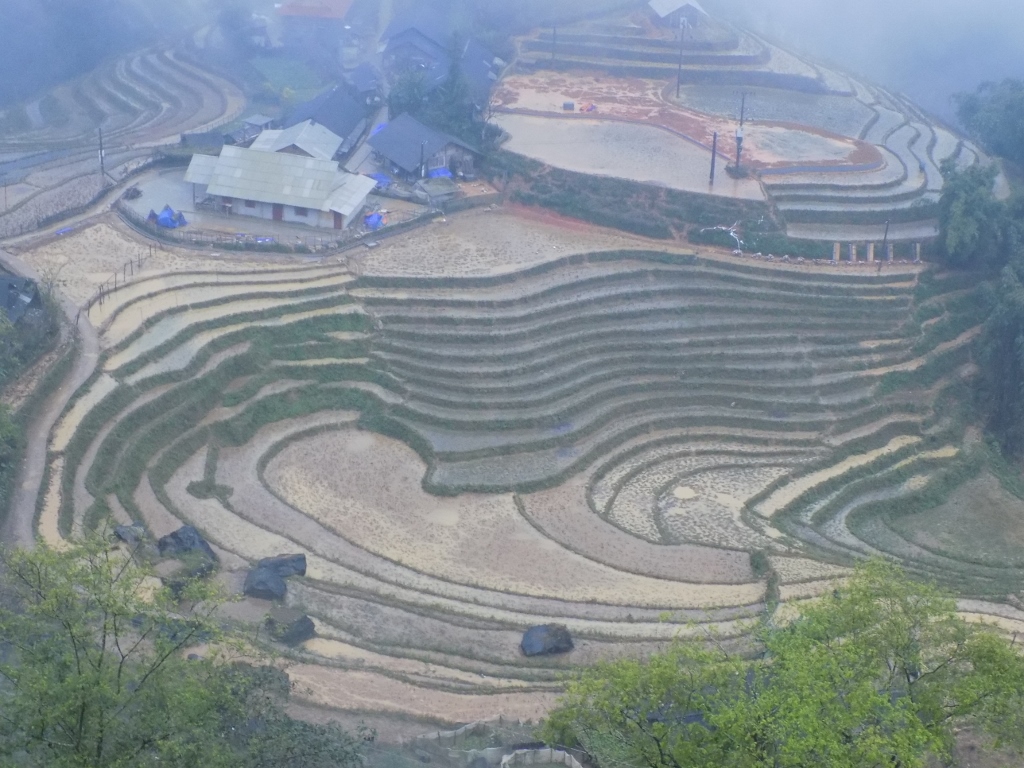 Rice paddies around Sa Pa
Rice paddies around Sa Pa
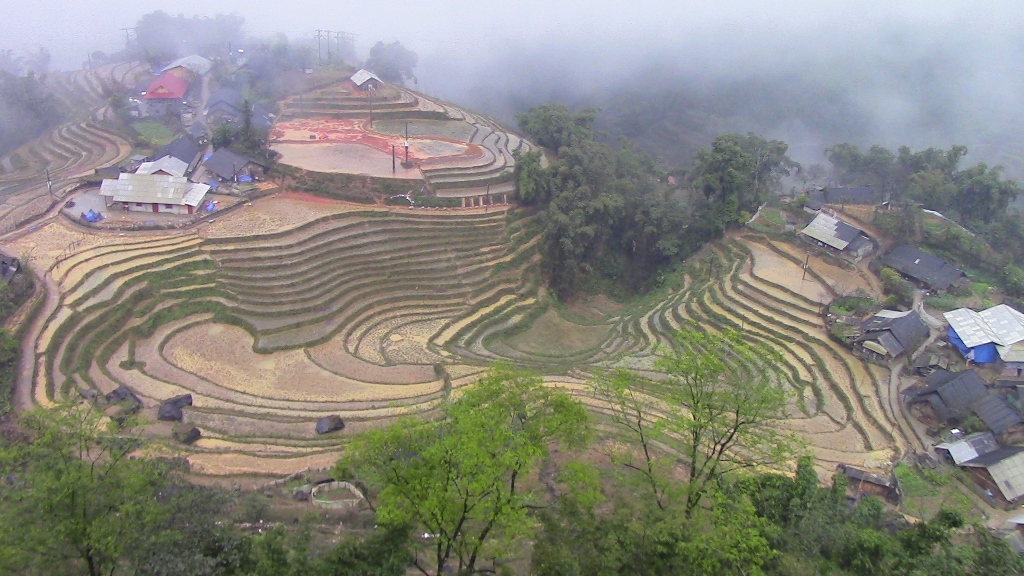 View at a property from the view-point
View at a property from the view-point
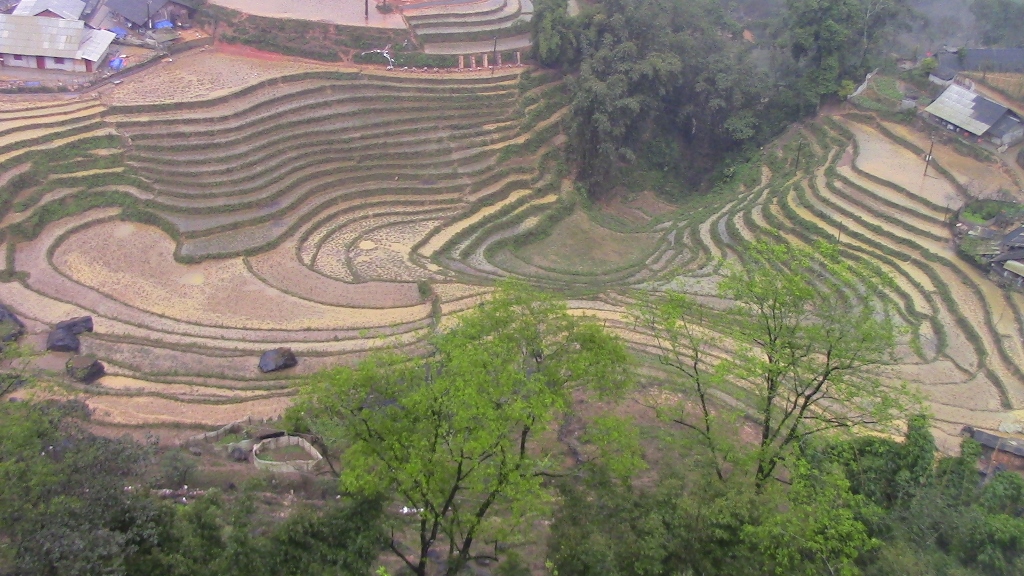 View at a property from the view-point, a detail
View at a property from the view-point, a detail
Over time our “boots” that did serve their purpose for a while started to be ripped by friction and pebbles over which we had to walk from time to time. There, on the ragged road, although there was some mud occasionally, the main culprit was water that kept coming from all sides, including also a couple of situations when we had to walk through water in the shape of torrents that rushed down the slope cut through by the road and going down on the other side. Chai did try to show us which stones to hop over in order to avoid those streams, but this often had no effect and our feet were already seriously wet. Our knees and the lower part of our thighs, above the “boots” and under the raincoat, were also completely wet. And so, after a few hours of walking in the rain and cold we finally reached the house in which Chai lives with her husband and their two children.
This was a beautiful, spacious house, made of good quality material, but... it was still not finished. And still far from being finished. It did have a roof and walls, and the house did not leak, but... the moisture and dampness were incredible and everything seemed to be wet. Thus, when we entered the large front room which served as a dining-room, in order to sit down and catch our breath for a minute or two, we first had to wipe the plastic chairs that were completely wet with condensation.
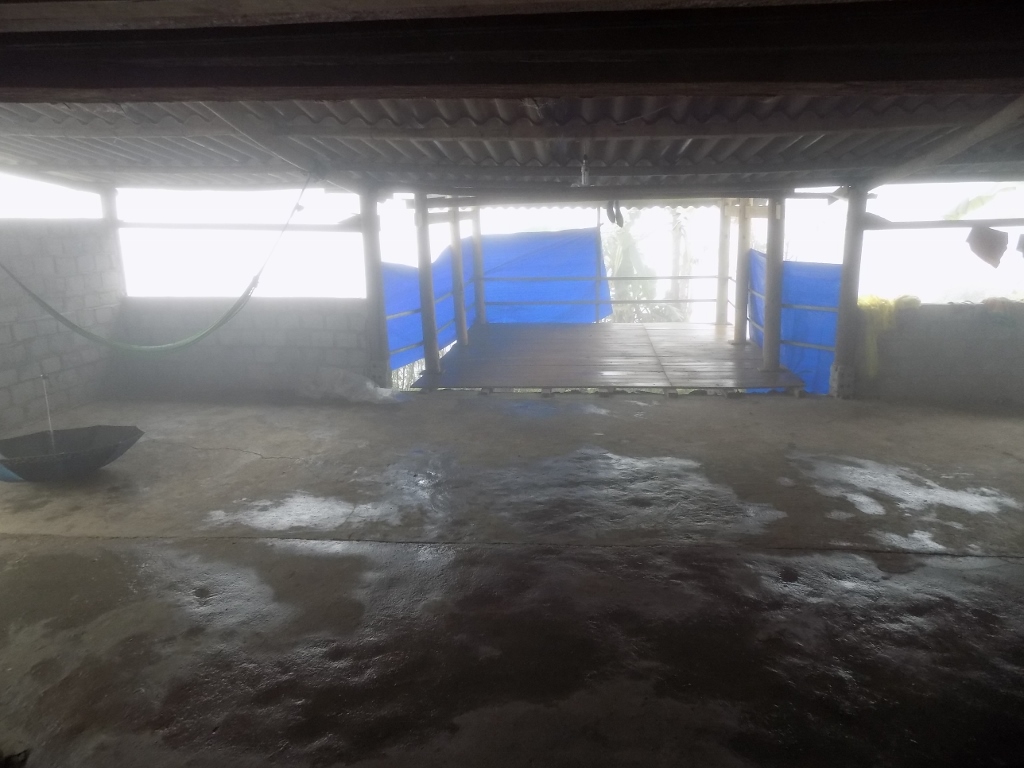 View from the dining-room door towards the balcony from where it is probably sometimes possible to see something
View from the dining-room door towards the balcony from where it is probably sometimes possible to see something
Chai showed us where our rooms were, but since the bed in the first room we saw was large, the two of us decided to sleep together in order to make sure that we would be warm, because, although we had two exceptionally thick blankets available, the outside temperature in which I could see the steam of my breath was not promising. (By the way, during the night it was around 1 degree Celsius). We could feel warmth only in the kitchen and only next to the fire, the hearth, which burned in a shallow hole in the concrete floor. Very soon we arranged our wet clothes and trainers there to dry. Directly above the fire there were pieces of meat that were getting dried and smoked there, and opposite the low stools we were sitting on there were numerous bags with rice placed against the back wall.
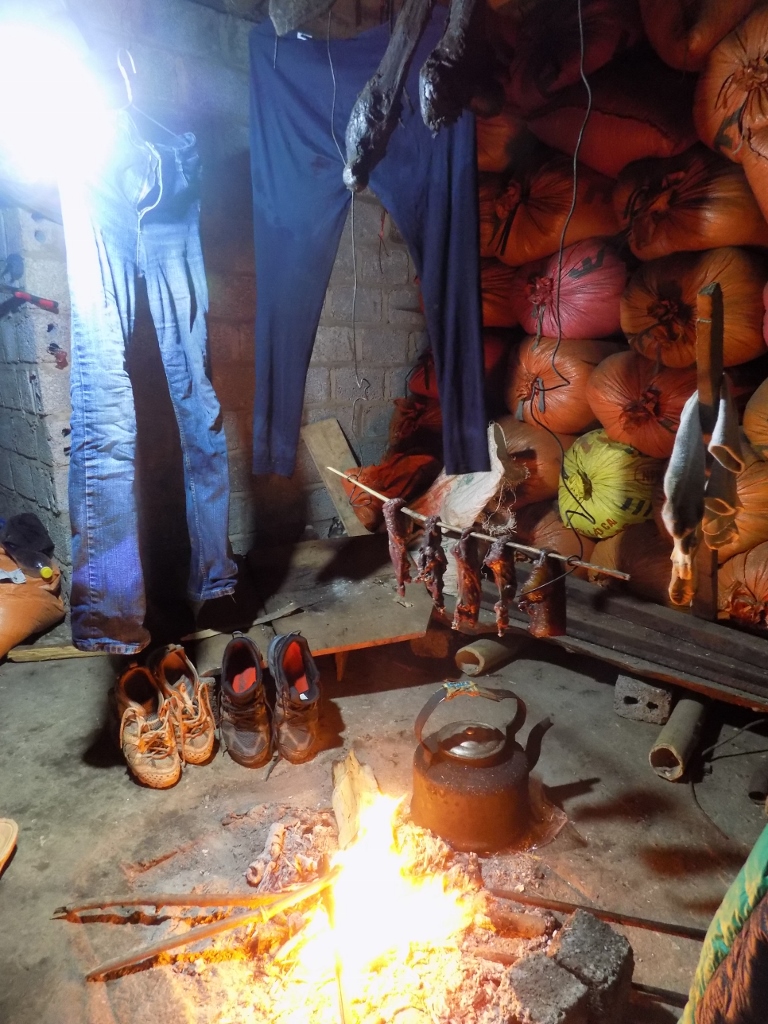 The only source of heath in the house
The only source of heath in the house
Under the circumstances, neither Sneza nor I even thought of having a shower, although Chai kindly offered it to us. We just felt too cold and we had had enough of water that day. In the meantime, I went completely down. I tried to remember how I slept in Montenegro when I did my hiking there and when I was not bothered in the least by the modesty of the accommodation (see: https://www.svudapodji.com/en/montenegro-3/ ). I wondered if in the meantime I had become too big for my boots and I could no longer stay at such modest places. I reached no conclusion that night, but later when I thought about it, I concluded that the advantage of the “unconventional accommodation” in Montenegro was that it was always warm, even when we would be caught in some rain. I think the main thing that bothered me here was the coldness and dampness that entered our clothes, went under our skin and into our bones.
Sneza courageously persevered, with no complaints. I felt additionally responsible, for it was I who had organized it all and made all the choices, but Sneza kept reassuring me it was all right. This was also an occasion in which a great quality of my friend stood out. Although we both like to “treat” ourselves from time to time to a nice accommodation or some particularly nice meal, essentially both she and I can endure some more difficult parts and even have a lot of spirit to be able to enjoy in them or even laugh at our own expense.
And so it was like this here in a way. To start with it helped that while we were changing our clothes and trying to get warm, Chai prepared a very tasty dinner. We sat and had dinner together with her and her children in the spacious front room in which the chairs had become damp again from the humidity, but the tasty food was a good thing and we slowly started to feel better and more relaxed. Then Chai’s 12-year old daughter asked as if we wanted to play cards with her. Why not? It wasn’t as if we had anything else to do. She showed us a simple game and so we had some fun for a while. As we were playing cards by the fire, all of a sudden the electricity went out and we were left sitting in complete darkness apart from the light of the burning fire. This accentuated even more the sound of the rain that kept pouring outside, but then the electricity came back. And then it went away again. And then it came back again. And so on, several times. We kept playing cards with Chai’s daughter, but eventually gave up and already around 8 pm went to bed.
While I was lying in bed, slowly getting warm under the two blankets, in addition to the incessant rain, the entire time I could also hear the noise coming from a nearby stream that was rushing down the slope. The water was all around us and I just kept remembering some news reports about landslides somewhere in the north of Vietnam. ... Still, at some point I fell asleep.
When I woke up the next morning, I could hear the sound of only one source of water and I realized the rain had stopped, for it was impossible for the stream to dry out suddenly overnight. I went out onto the veranda wrapped in a warm blanket, but it was still impossible to see anything much. Just a banana in front of the veranda and mist.
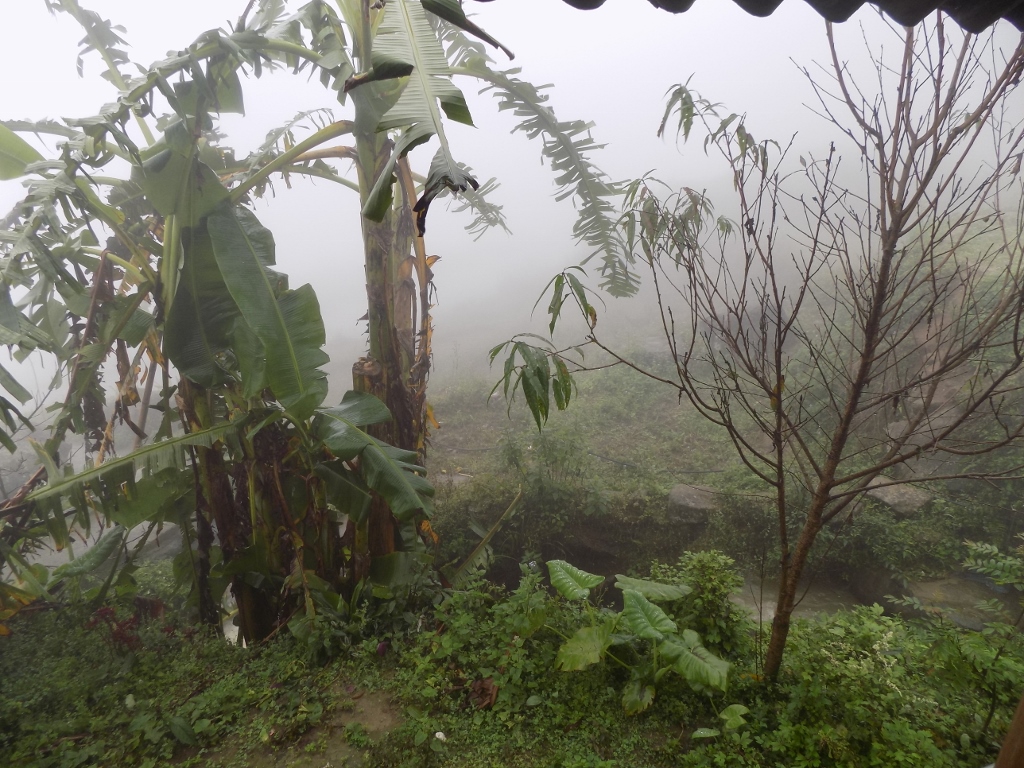 View from the balcony of the house in which we stayed in Sa Pa
View from the balcony of the house in which we stayed in Sa Pa
While Chai was preparing breakfast, we were again getting warm by the fire, as well as making sure our clothes and footwear of yesterday were completely dry. Even what was dry the previous night, had absorbed dampness during the night and was quite unusable now. Still, it all dried after some time and we had a nice breakfast consisting of scrambled eggs, pancakes with honey and bananas. As it turned out, this was a typical breakfast for tourists, for we had the same in all the private accommodations we stayed at.
We also had to wait for Chai to prepare pig’s legs for later when she would be cooking dinner. This preparation consisted of her sticking a pig’s trotter onto a thin metal bar turning it over an open flame until the leg became all charred. Chai actually did this with two trotters in parallel. Then she washed them in a wash-pot when she was also clearing off the horn that covers the hoofs. She said the trotters would be cooked later on in order to make a meal out of them. She also mentioned that they eat the entire pig in Vietnam, including bones. Apparently, they cut them very thinly and then they eat them. It did not sound too appetizing to me.
After all of this, we left for a walk with Chai, as was envisaged by the tour plan. First we stopped at a local museum in the village of Ta Van which in addition to the folk costumes and customs of different tribes living in this region also dealt with the stones that I was particularly interested in and that are in the UNESCO’s Tentative World Heritage List.
Namely, in 1925 a French explorer “discovered” these stones. These are actually large boulders that protrude from the surrounding ground and that are engraved. So far, around 200 such engraved rocks have been found in this region, around Sa Pa. The explorers have discerned different types of engravings on them, from simple lines to zoomorphic and anthropomorphic images, but basically to this very day nothing much is known about them. There are some indications suggesting that the stones were engraved around 2000 years ago, but it is still not known exactly who did this.
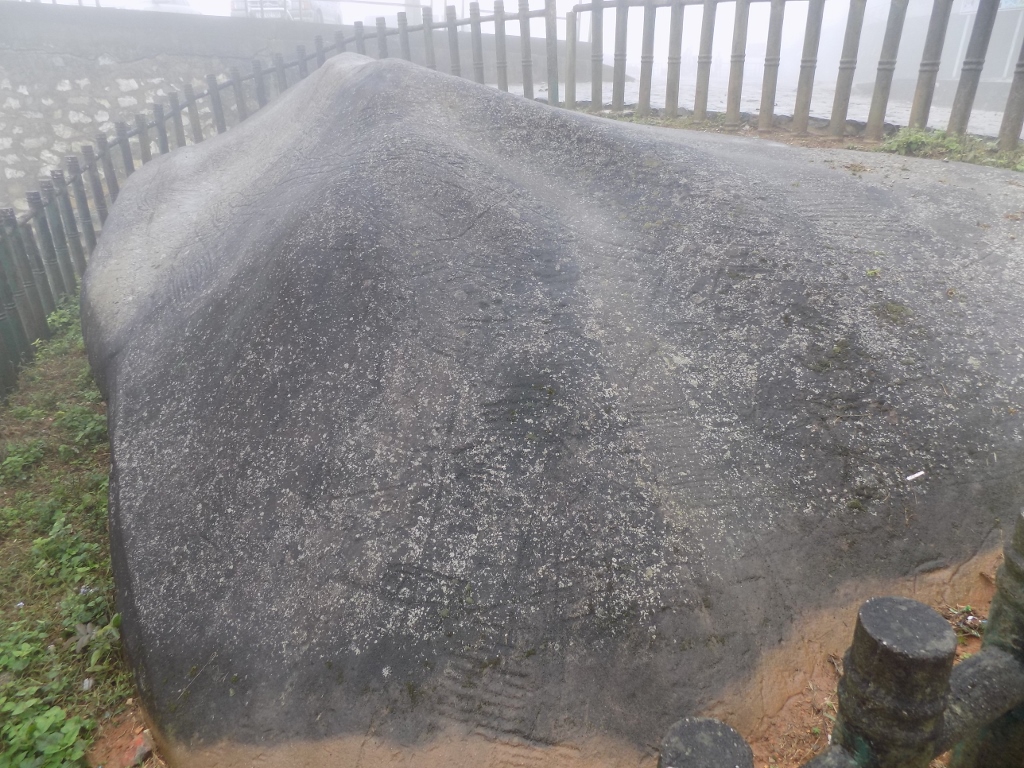 An engraved rock close to the museum in the village of Ta Van
An engraved rock close to the museum in the village of Ta Van
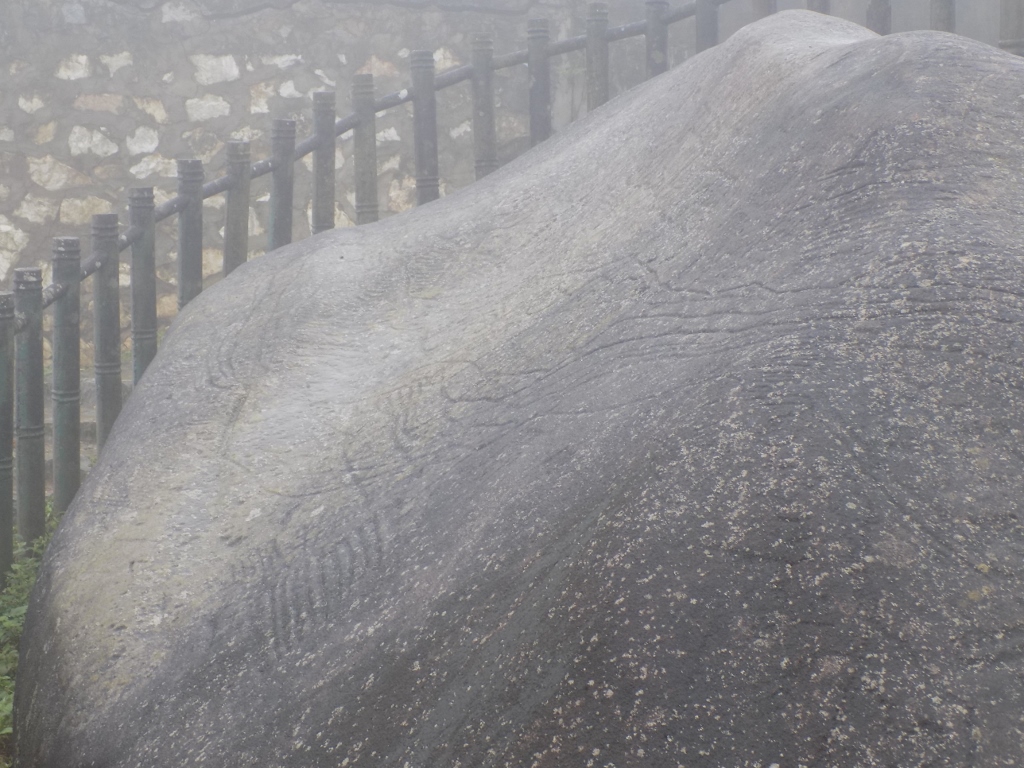 An engraved rock close to the museum in the village of Ta Van, a detail
An engraved rock close to the museum in the village of Ta Van, a detail
Soon we got off the road following a path that led us beside those muddy rice paddies arranged on the terraces I have already mentioned, as well as by a smaller rock. Chai paid no attention to it, but rather took us to the biggest rock in the area. We took a few photos, but this was still a challenging task because of the permeating humidity. My glasses got fogged, as well as the lens on my camera, and if I wanted to clean them, my shirt was damp and it was problematic. Still, I was pleased in the end. I saw “only” three out of 200 such boulders, but taking into consideration the weather conditions, it was perfect.
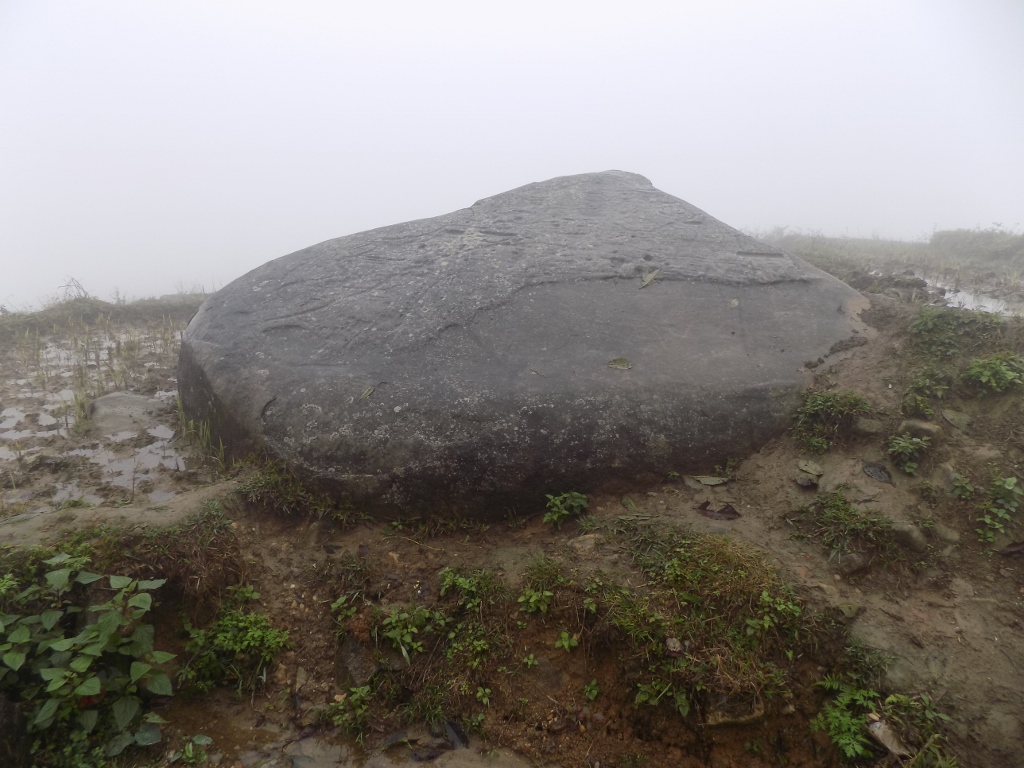 An engraved rock in the middle of a rice paddy
An engraved rock in the middle of a rice paddy
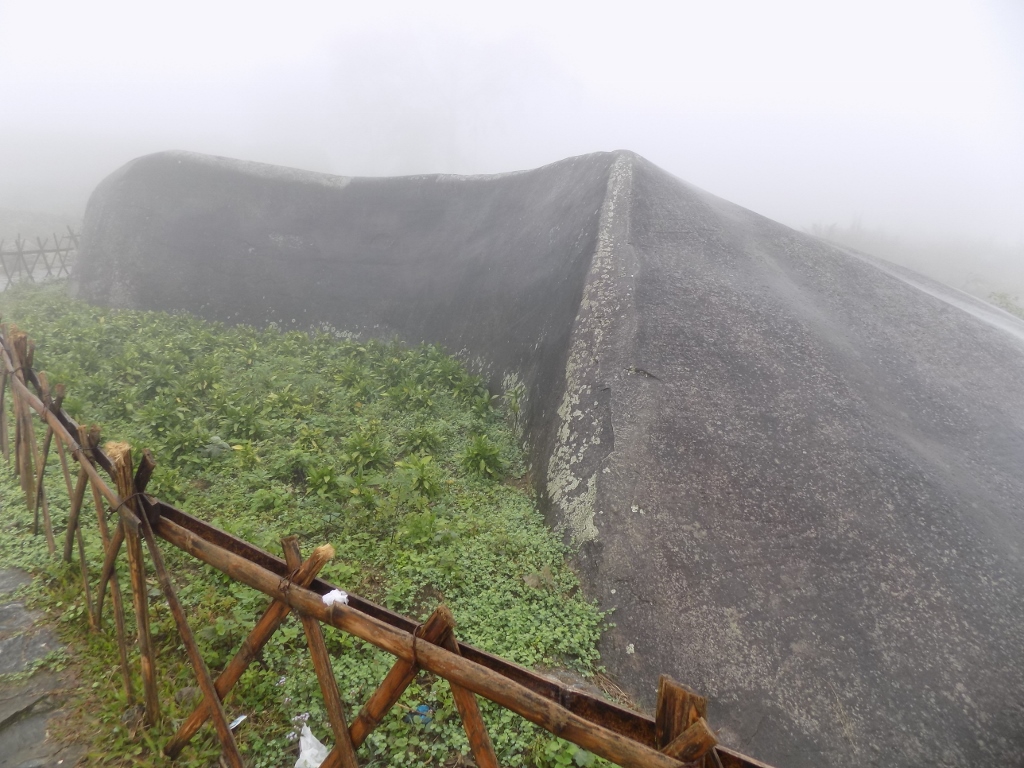 The biggest engraved rock in the area, it is some 12 metres long
The biggest engraved rock in the area, it is some 12 metres long
After we had visited these few rocks, we continued walking along the road and soon we moved onto another side path, heading for a waterfall. All or most of the tours take visitors to this waterfall. The path goes between village houses and fields and in one spot we made a stop by a small plot of land with the indigo plant. When crushed, the leaves of this plant render the indigo colour. Actually, they first render green, which then turns indigo, and this colour is used broadly by the local women for dying fabrics. I had to try this, but in the meantime, it had started to rain again.
Then we went down to the waterfall, which was nothing special, but we still stayed there a little in order to take photos. After all, we just did what all other tourists we saw there were doing. Then we started to go back, but along yet another path, going uphill for quite a while. I had a raincoat on and soon started to perspire under it, so that I was completely wet from the “inside” when we reached a local restaurant where we were to have lunch. First I started to take my clothes off, for I felt quite hot, and while we were waiting for the food I started to feel cold, because there was no source of heat whatsoever here where we were sitting. The shirt I had taken off was completely wet now and completely cold, so there was no way I was going to put it on again. Luckily, I had enough material in my small backpack to be able to improvise.
After the lunch, a mini-bus took us to the centre of Sa Pa together with some other tourists who had lunch at the same place, but along the way we stopped by Chai’s house in order for Sneza and me to take our big backpacks. Since it still kept raining, we put our backpacks again under the canopy above the entrance into the church (which was closed anyway) and we went to look for a shop with water and food. We found one, but along our way we came across some other sights. Here are a couple...
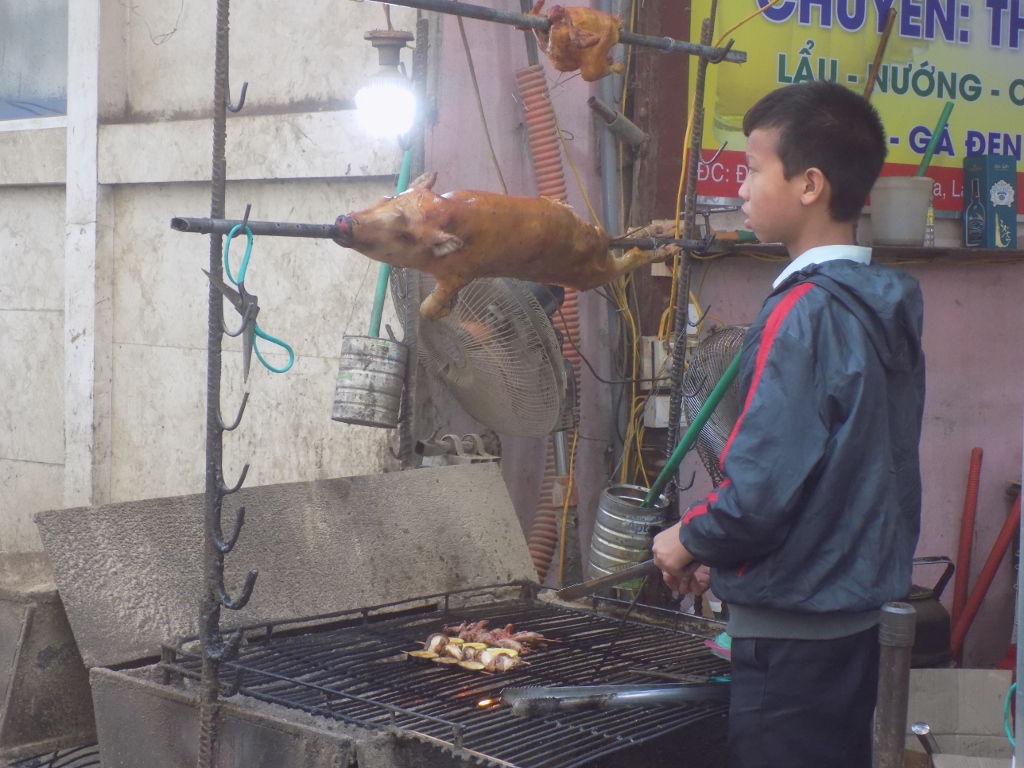 A spit-roasted suckling pig in the streets of Sa Pa
A spit-roasted suckling pig in the streets of Sa Pa
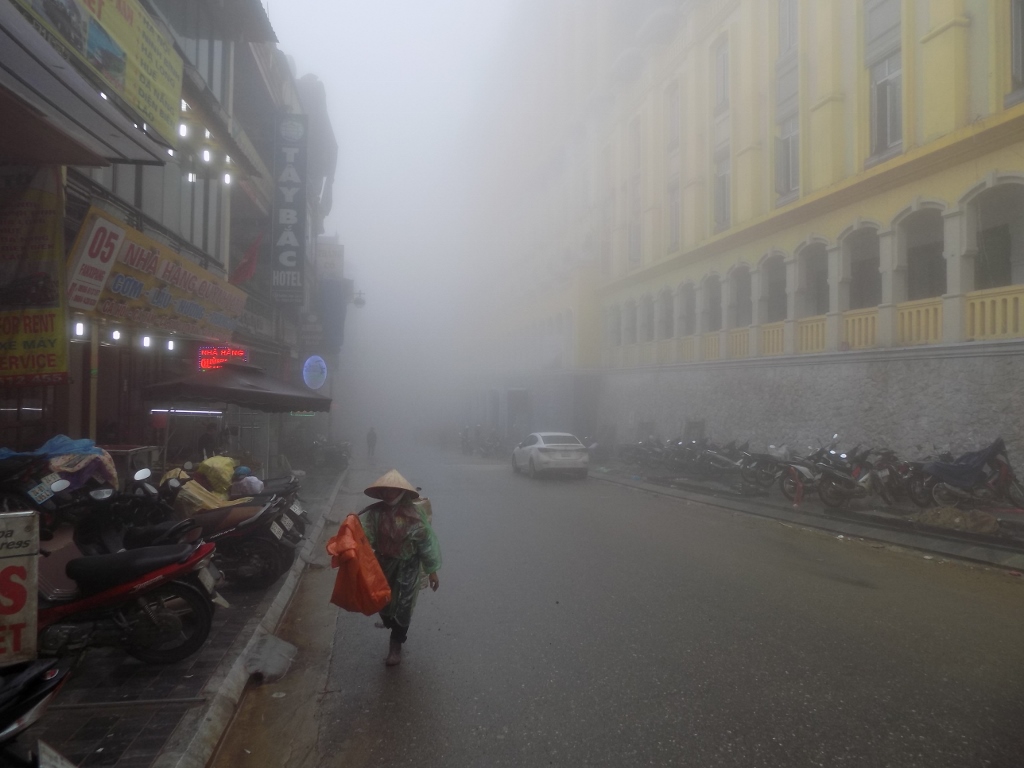 This is what we saw of Sa Pa before leaving
This is what we saw of Sa Pa before leaving
Since we bought water and some snacks for the trip, we went back to the church and our backpacks, and soon we headed back to Hanoi in the same type of coach as the one in which we had arrived the day before.
While travelling around Vietnam in the following weeks, we met some people who told us that they had met a girl who in the meantime had been in Sa Pa and that she had had four gorgeous sunny days there. As it turned out, both Sneza and I actually had the same thought at such information – “Lying bitch!”